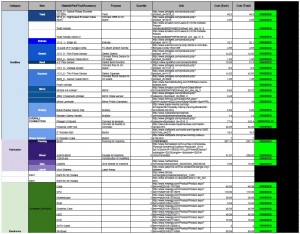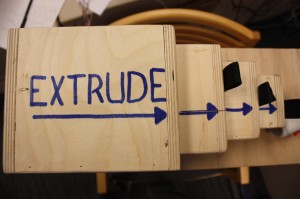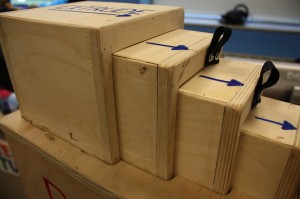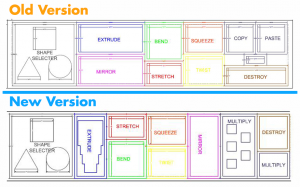Project: Take Shape
Week Ten Newsletter
11-2-2012
Week Ten: Taking Shape
Following up with our Halves feedback, the Take Shape team met Monday morning and discussed a number of details surrounding our machine, the user-interface and the connections between the two. One of the biggest feedback concerns from faculty and staff revolved around the correct terminology of the modifiers, specifically that our extrude modifier would
be a number of other terms; in the end, nobody could reach a verdict one way or the other. We also heard feedback that pertained to safety of children’s fingers and getting pitched or caught in something as well as the ability to clean the machine from day to day.
To counter this feedback we decided on a variety of solutions to restructure our dashboard in order to improve correlation of physical to digital, means of sealing our birch paneling to avoid staining while improving cleaning capabilities, and a redesign of the user-interface to add in our multiply screens, text area and focus on making the primitive the absolute center of attention.
To start, Kevin and I rearranged the dashboard to put the modifiers in an order that reflects the order of operations Kai, Andy and Dan generated. This will help ensure that the modifiers which function the best simultaneously will be closer together and the modifiers that would typically be at the end of the modeling process are towards the opposite end of the shape selector. We hope that this will be a subconscious learning objective to expose children to the correct order of operations, much like a math problem. The rearrangement also consisted of removing the mirror function along the Z-axis as, after a few discussions, was rendered meaningless due to traditional modeling procedure. In addition we also remounted the extrude modifier to be pulled vertically on the dashboard as opposed to horizontally; all of which helps to connect the physical to digital.
In order to make the multiply functionality have a positive impact we were forced to redesign the layout of our on screen content.
Previously we had the primitive model front and center on the screen with the relative kinetic typography showing up where there was empty space. Now we have reversed the direction of the primitive so that, when mirrored, the clone will appear to the left instead of the right. This gave us space to develop a UI for five different multiply spaces. Essentially, when a child picks up the stamp pad (the physical input for multiply) the program will instantly store the mesh of the primitive in whatever form it is at the time. This mesh is then displayed in one of five positions relative to the stamp positions on the physical dash panel. The child then has the option to paste as many versions of the current selection as he or she would like. The objects that are multiplied will not change due to further input of any modifiers but as soon as the stamp pad is returned to its original position a new version of the object to multiply will be stored within the program.
With a total budget of roughly thirty-five hundred dollars we still had close to two thousand left to order. This included big ticket items such as the television for our display, the computer  components to run the machine, cooling fans, USB hubs and a few more Phidget sensors for our remaining modifiers. To ensure this all is delivered in time to fabricate and incorporate we sat down yesterday, reviewed and placed a large order for many items. As students in the land of technology and entertainment we are as excited as children on Christmas eve as we anticipate the arrival of our goods and materials.
components to run the machine, cooling fans, USB hubs and a few more Phidget sensors for our remaining modifiers. To ensure this all is delivered in time to fabricate and incorporate we sat down yesterday, reviewed and placed a large order for many items. As students in the land of technology and entertainment we are as excited as children on Christmas eve as we anticipate the arrival of our goods and materials.
To round out the week we will be preparing for a play test at the MAKESHOP on Sunday in which we will be putting our machine in front of both children and staff of the MAKESHOP for the first time. We are eager and nervous for their reactions but are hoping for the best. Things we will be looking out for include height of the machine, intuitiveness of additional modifiers, programmatic functionality/limitations, comprehension from children and durability of the machine overall.
With the play test deadline approaching it is time we all get back to work now, check back soon for updates and photos regarding our latest revision.


